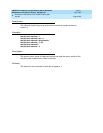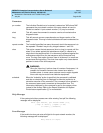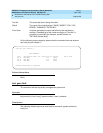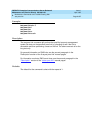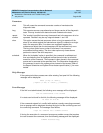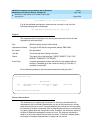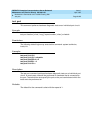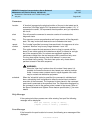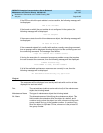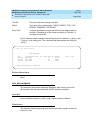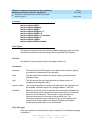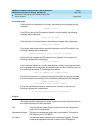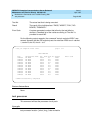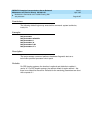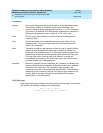
DEFINITY Enterprise Communications Server Release 5
Maintenance and Test for R5vs/si
555-230-123
Issue 1
April 1997
Maintenance Commands and Trouble-Clearing Aids
Page 8-641test port
8
Parameters
Help Messages
If the system technician presses HELP after entering "test port" the following
message will be displayed:
Enter port location, [’long’ or ’short’],
[’repeat’ (1-100) or ’clear’], [’schedule’]
Error Messages
If the format for the port location is incorrect, the following error message will be
displayed:
Port/Board invalid
location A "location" represents the physical position of the port to be tested and is
entered as "UUcSSpp" where "UU" represents the cabinet number (1-3), "c"
represents the carrier, "SS" represents the slot position, and "pp" represents
the circuit.
short This will cause the command to execute a series of nondestructive
diagnostic tests.
long This executes a more comprehensive and longer version of the diagnostic
tests. This may involve both destructive and nondestructive tests.
repeat
number
The "number" specifies how many times each test in the sequence is to be
repeated. "Number" may be any integer between 1 and 100.
clear This option causes the test sequence (short or long) to repeat until the
alarm (if one exists against the maintenance object) is cleared or a single
test in the sequence fails. If no alarms are registered against the
maintenance object then the test sequence will be exercised only once.
The long clear option forces a clear of all alarms if no errors are
encountered during testing. The short clear option only clears alarms
pertinent to tests in the short sequence.
!
WARNING:
Since the "clear long" options clear all counters if tests pass, it is
possible for firmware counters to be cleared even when a problem
exists. In some cases customer service might degrade since calls
may be routed over defective equipment.
schedule When the "schedule" option is specified, the command is validated and
then a scheduling form is displayed to allow the technician to schedule
execution of the command. The command is then placed in the command
queue and is executed at the specified time. The information displayed by
the command is sent to the system printer instead of the screen. Refer to
the Report Scheduler and System Printer feature specification [1] for more
details.



